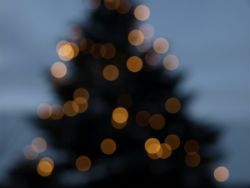
Holiday lights bring joy to the season, but they can also bring hazards, according to Pacific Gas and Electric Company (PG&E).
An estimated 400 home fires involving Christmas trees or holiday lights occur each year in the U.S., resulting in 21 deaths and $25.2 million in direct property damage, according to the National Fire Protection Association and the U.S. Fire Administration.
PG&E encourages its customers to keep safety in mind as they decorate their homes and trees in the coming weeks. PG&E offers the following holiday lighting safety tips to reduce the risk of fire and injury:
- In addition to being shatterproof and shock resistant, LED lights produce almost no heat, making them safe to touch and greatly reducing the risk of fire.
- Look up and live! Before stringing outdoor lights, check for overhead power lines. Never place yourself or any object in a position that risks contact with a power line—the result can be fatal. Look up before raising ladders or other objects. Keep at least 10 feet away from overhead lines.
- Before stringing lights on outdoor trees, make sure tree limbs haven’t grown into or near power lines. Branches, entire trees and even the ground adjacent to a tree can become energized when trees contact power lines.
- Make sure lights outside the house are approved for outdoor use. Never use indoor lights outdoors.
- Follow the manufacturer’s limits for the number of light strings that can be connected together safely.
- Check all light strands for cracked or broken plugs, frayed insulation or bare wires. Worn cords can cause fires, so discard damaged sets of lights.
- Route cords inside your home so they won’t trip anyone. Don’t place them under rugs, furniture or other appliances. If covered, cords can overheat or become frayed, increasing the risk of fire.
- Always turn off decorative lights—indoors and outdoors—when leaving the house and before going to bed.
- Do not place your tree near a heat source such as a fireplace or heat vent. The heat will dry out the tree, making it more susceptible to fires caused by heat, flame or sparks.
For more information, visit www.pge.com.




